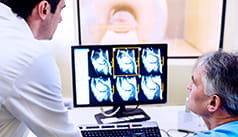Uterine Cancer (Endometrial Cancer)
CONTACT US:713.790.2700
INTERNATIONAL:+1.713.441.2340
Find a Uterine Cancer Specialist
At Houston Methodist Cancer Center, our gynecologic cancer specialists use a team-based approach to diagnose and treat uterine cancer, which is also called endometrial cancer. We provide advanced cancer care at seven locations across the Greater Houston area, allowing you or your loved one to receive treatment close to home or work.
Why Choose Houston Methodist for Uterine Cancer Treatment
Our specialists, nurses and staff coordinate your cancer care in a compassionate, supportive environment that is supported by a team-based approach and research.
The benefits of choosing our uterine cancer care team include:
- Expert oncologists who work together to develop a treatment plan tailored to your specific condition and lifestyle needs
- Advanced diagnostics and treatment options, including minimally invasive surgical techniques and robotic technology
- Oncology nurse navigators who guide you through your cancer care — from diagnosis through survivorship
- Support through and beyond your recovery
Access to Cutting-Edge Clinical Trials Close to Home

Our physicians support numerous cancer-specific clinical trials, meaning you may have access to new and potentially promising treatments that aren't available elsewhere.
